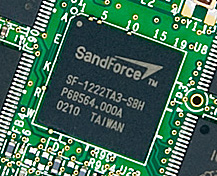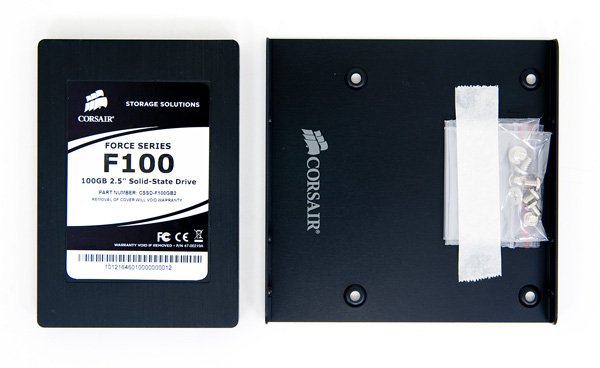Understanding SandForce's SF-1200 & SF-1500, Not All Drives are Equal
by Anand Lal Shimpi on April 16, 2010 11:30 AM ESTWhere Do We Go From Here?
Corsair is under no obligation to ship drives with the 3.0.5 firmware. Assuming there are no other problems with the 3.0.1 firmware, Corsair could presumably keep shipping the higher performing OCZ-like firmware. The problem is that if you ever need to upgrade your firmware, you could lose performance.
As I've mentioned in the past, customers of whatever company or companies work closest with the controller manufacturer will undoubtedly get access to firmware quicker than anyone else. We've seen this work both in favor of and against the best interests of the consumer. Sometimes you get features/performance early (e.g. TRIM support for Indilinx drives) and other times you get early, untested firmware. Your best bet at this point is to hold off on any SF-1200 purchases unless you're willing to accept the risks that comes with.

The case isn’t closed on this issue however, not by a long shot. It’s my understanding that the SandForce/OCZ exclusivity agreement is currently only a short term agreement. While the companies are in the process of negotiating a long term agreement, nothing is final yet.
There are some measures in place to ensure that you can’t flash an OCZ firmware on a non-OCZ drive (and vice versa) but there’s nothing saying that at some point this won’t change either.
We also don’t know what the real world impact of the standard SF-1200 firmware will be. I’m hoping to have a standard SF-1200 drive with production firmware very soon and I will report my findings as soon as possible.
I’ve also communicated to SandForce that this should have never happened. It was well aware that there would be a performance difference between the Vertex 2 and all other SF-1200 drives, and there’s absolutely no reason any company other than OCZ should have had 3.0.1 with that exclusivity agreement in place. It’s simply not right to give your partners performance that you know for a fact will later be taken away. SandForce indicated to me that everyone was aware that performance could change between firmware revisions, but in my opinion this is still not being totally transparent. The moment a review based on Corsair’s Force drive went live, SandForce should’ve had a discussion with Corsair and the reviewer. We weren’t the first to review the Force drive, but it wasn’t until after our review went live that SandForce contacted us.

SandForce is a very young company and this just sounds like a bad case of partner mismanagement. Thankfully there haven’t been that many SF-1200 drives sold, but if you’re considering one you have to keep in mind that you could see performance drop in one metric with a firmware update. Note that the drive will still perform as specified, the SF-1200 controller is only rated for 10,000 sustained 4K random write IOPS.
There’s also the issue of SSD makers shipping drives based on firmware that’s not MP ready. I’ve established a more direct line with SandForce so I’ll at least be made aware of what firmware is ready for shipping and what isn’t. I’ll also be putting more pressure on manufacturers to only ship MP ready firmware. Let this serve as a warning to SSD manufacturers. I haven't been keeping close tabs on shipping firmware revisions since I never recommend any brand new, unproven SSD controller. But clearly I'm going to have to start docking points for not following controller manufacturer guidance. This stuff is serious guys, you're playing with our data here - I can't stress that enough.
As I keep mentioning in my coverage of SandForce and any other new SSDs, if you jump on board you’re assuming a risk. These drives and controllers are largely unproven. While I’m doing my best to put them through their paces, I can’t test every system combination. On top of that, many of these companies are newcomers to the industry and as an early adopter, you might find yourself in the middle of a situation like this.
This is unfolding in real time so I’ll keep you posted as I come across any new developments.










81 Comments
View All Comments
bplewis24 - Friday, April 16, 2010 - link
It's pretty sad that one of the only places I can go to get real, actual (somewhat investigative) journalism and insight is a tech site. This is great stuff, Anand. Keep up the good work.Brandon
NGneer - Friday, April 16, 2010 - link
Just wondering if the last line on page 2 has a typo regarding MP vs RC or possibly I'm just confused."just slower than with the MP firmware and slower than OCZ’s Vertex 2."
Anand Lal Shimpi - Friday, April 16, 2010 - link
Woops, you're correct :) Fixed.Take care,
Anand
529th - Friday, April 16, 2010 - link
In an infant market segment, it seems Sandforce is trying it's best to get as much user feedback from their product stepping over their exclusive agreements. But it seems OCZ and Corsair are in the same boat with their SF1200 controlled SSD drives. It's basically a morality call from Sandforce that falls on some segment of end-users in order for a company to speed up the development of their firmware for their controllers in order to not fall behind in the best controller war. Q4 is right around the corner for Intel and while the 25nm chips will help even further push their proven conglomerate that makes up their SSD drive lets hope we have a few different companies that keep the prices competitive.cjl - Friday, April 16, 2010 - link
The comment in the article" In a population of 10,000,000 controllers, with a rating of 10,000,000 hours, the probability is that 1 unit would fail in an hour. The SF-1200 would have 5 units fail in the same time. The failure probability drops as the number of controllers drops (SF won’t be shipping anywhere near 10M of these things)."
is flawed in several ways. It assumes a linear failure rate (I.E. that your drive is just as likely to fail in the first hour as it is after 200,000 hours), and it assumes that 100% of drives will fail by the rated lifetime (in other words, in a population of 10,000,000, 1 will fail each hour and all will be dead at 10,000,000 hours). In reality, the failure distribution is quite different, usually with a higher failure rate in early life, a lower failure rate for most of the rated lifetime, and a rising failure rate again as you approach the MTBF.
To use the same example as above, if you had 10,000,000 drives, you would probably see more than one fail per hour in the first couple of weeks, followed by a much lower than 1 per hour failure rate once the initial ones had died. Then, when approaching the design lifetime, you would again begin to see the failure rate climb, with an expected 5,000,000 drives to be dead by the MTBF of 10,000,000 hours (assuming a somewhat symmetric failure distribution).
jasperjones - Friday, April 16, 2010 - link
"The failure probability drops as the number of controllers drops (SF won’t be shipping anywhere near 10M of these things)."Why should the probability be a function of the number of controllers? That doesn't make any sense.
taltamir - Friday, April 16, 2010 - link
probability is not affected by number of controllers, MTBF is a bullshit metric that means nothing at all... also check out the MTBF on spindle drives (1.5 million most common vs the 2 million and 10 million listed by sandforce, the smallest i have seen was 300 thousand hours (still it means decades))Ramesh Rawat - Friday, April 16, 2010 - link
Having visited AnandTech recently, and with my very poor limitations and knowledge in this field, more specifically about the technical evaluations done by Anand, I was and I cannot resist to thank this site for making me aware about SSD. Subsequently I am upgrading to Intel SSD purely because of the reviews of Anand ji.Thanks to Mr. Anand.
Ditiris - Friday, April 16, 2010 - link
This deserves an "attaboy." Thanks for alerting your readers, and please keep up the good work.Exodite - Friday, April 16, 2010 - link
Very interesting article.Like many others this is the kind of information that keeps bringing me back to Anandtech.
The question on my mind then would be if there's even any SF1500 drives shipping, or known to be planned?
As it seems to every SandForce-based drive on the market, or having been announced, either run the SF1200 (with or without high-performing firmware) or the limited run hybrid chip.
What pricing and performance differences can we expect?
If the main differences are mainly reliability and SLC support I see no reason to artificially limit performance of the SF1200, not that I'd ever support that anyway, as the benefits of the SF1500 would be mostly meaningless for consumers but still attractive for enterprise use.
Ah well, time will tell I suppose.